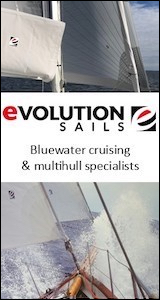Forum Replies Created
-
AuthorPosts
-
 PaulKParticipant
PaulKParticipantYour question about roller-furling and roller-reefing gets into some technicalities. The terms can be confusing. Boats can have roller-furling mainsails, jibs, and spinnakers. Mainsails and jibs can be designed and built to be used partially rolled or unrolled, which makes them roller-reefing sails. If they’re not designed and built to be used partially rolled, the sail shape will become too baggy to perform well in heavy winds, even if the exposed sail area is reduced. With the relatively small jib on a Hunter 38, using it partially rolled in heavy air might not be overly effective. Depending upon the point of sail and wind strength it might simply be better to furl the jib entirely.
-
This reply was modified 2 years, 1 month ago by
 PaulK.
PaulK.
 PaulKParticipant
PaulKParticipantHow jibs attach to the forestay depends upon the forestay. If it’s just a wire or rod, the sailmaker will use hanks. If the forestay has grooves (like a Tuff-Luff, which doesn’t roller-furl)- there will be a luff rope that slides up the groove. The sail areas are different because the r/f sail’s foot has to be cut higher, to enable it to roll up without bunching and jamming the r/f fitting. Non r/f sails don’t have this problem, so they can go all the way down to the deck, adding more sail area and creating an “end plate” effect.
 PaulKParticipant
PaulKParticipantPeople have sailed Albin Ballads all over the place. They have reputations as decent sailboats, but they are small cruising boats, not designed to handle the Roaring 40’s. Though they might heel a bit more than newer designs, they should be able to handle typical good summer weather anywhere in Europe. If you search for them under used boats for sale, many are based in the North or Irish Sea, but others are in the United States or further afield. This would indicate that they sail well in these areas, or people would not have taken them there. They are quite capable boats.
 PaulKParticipant
PaulKParticipantThere is a pattern to HIN numbers that usually shows the design (18 at the start of yours might be that) the year of construction (maybe ’82?), what month the boat was built, and the number of the hull, along with some other information. Google may may find you something online that explains it properly.
 PaulKParticipant
PaulKParticipantHave sailed on a bunch: Ohlson 38, Whitby 45, Concordia 40, Hinckley Bermuda 40…
also: Pearson 36, Pearson 40, Swan 40 (S&S), Swan 40 (Frers)…
There are a lot out there. Your best bet might be to look for boats from the 70’s and 80’s in your size range here on Sailboatdata and see what their interior layouts show. PaulKParticipant
PaulKParticipantSeems like you’ll need to haul out to get it fixed anyway, which would enable you to figure out how it works. Fairport Yachts (Ohio) bought the C&C brand and might have some information. Have you contacted them?
 PaulKParticipant
PaulKParticipantLots of possible reasons for this to happen. Marine growth (zebra mussels?) in the centerboard slot, or rocks from a grounding could be jamming it. Taking a swim to have a look-see might help determine the problem.You may be able to stick an oar or paddle between the hull and the board and persuade it to move.
 PaulKParticipant
PaulKParticipantSome of what you seek is available here on Sailboatdata: https://sailboatdata.com/sailboat/vega-27-albin/. “Deadweight” would be the displacement. You could also use the plan drawing (it is to scale) to determine what the freeboard is. You will have to define the “total height of the side”. It is not a common term. When these boats were first built there may not have been an official “number of people on board” maximum. Now, the number might vary according to requirements in different countries, or might vary depending upon how the boat is being used. Six people might be needed for overnight racing, for example, while in a day race having that many on board would be very crowded.
July 22, 2023 at 2:56 am in reply to: buccaneer 210, Identify sail fabric type for purpose of cleaning #89287 PaulKParticipant
PaulKParticipantIf it is a synthetic material, any dishwashing soap (Dawn, Joy, Palmolive, etc.) and water will work. It is easiest to spread the sail out on the grass and use a soft bristle brush, rinse, turn the sail over, and repeat. Getting it up off the grass will help it dry. We used to see a neighbor’s sails drying, hoisted from a tree branch in his yard.
-
This reply was modified 2 years, 3 months ago by
 PaulK.
PaulK.
 PaulKParticipant
PaulKParticipantIf you want something quicker, a J/boat would be the right answer. For quicker with comfort, perhaps a Beneteau 36.7
 PaulKParticipant
PaulKParticipantThat looks ragged enough to make it difficult to repair in wood. You’d have to make the hole bigger just to square it off. It already appears like it’s got a bevel on three sides. Filling it in with a fiberglass/epoxy repair would be quicker & easier than wood. Maybe with a waxed piece of plywood on the inside to create a mould & support it until it kicks. A layer or two of ‘glass cloth/epoxy, then some epoxygoop with chopped fibers for strength, then another layer or two of ‘glass cloth/epoxy to tie it in with the outside of the hole. Sand it smooth on the outside and you’re ready to paint.
 PaulKParticipant
PaulKParticipantIf scarfing the repair into the hull would make the repair too big, perhaps you can simply fill in the hole neatly and put a big backing block – similar to a butt block used in carvel planking – on the inside. Do note that the scarfing ratio is based on the thickness of the plank you’re scarfing in to. If the hull is 1/2″ thick, the scarf would extend out 4″ from the edge of the hole if you’re working with an 8:1 ratio. Do note that, according to Google:“Traditionally, scarf ratios have been driven by the location of the scarf: 4:1 for planks, 6:1 (possibly 8:1) for keels, and 12:1 for spars.” If you make the repair with epoxy instead of wood, the ratios may be different.
January 20, 2023 at 1:55 am in reply to: Desperately need William Garden Porpoise Sails dimensions #86160 PaulKParticipant
PaulKParticipantA sailmaker might have a database or book of sail dimensions they could refer to. Check with one of them.
 PaulKParticipant
PaulKParticipantBecause V-berths are a funky shape, we use two flat sheets. The bottom sheet can get tucked in under the cushions all along the sides, the bottom and top, so that it lies nicely, snug and flat on the cushions. The top sheet gets tucked in at the foot and the sides. Using oversized (King) sheets provides plenty of material to get tucked in, so that it doesn’t move much, if at all. Using fitted sheets for this would be a nightmare, unless they were measured and sewn precisely to match the exact shape – which would be its own nightmare to make. Even if you had the dimensions of the berth, you’d need to know how thick the cushions were as well for fitted sheets to actually fit. A cooler might be a better idea – but let him figure out where he wants to put it.
 PaulKParticipant
PaulKParticipantThe size of the battens depends upon the size of the batten pockets, and they can vary considerably. If you don’t have the sail at hand to measure how wide the pocket is, it might be best to call the sailmaker
-
This reply was modified 2 years, 1 month ago by
-
AuthorPosts




